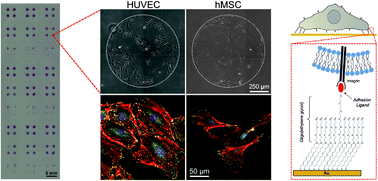A chemically-defined screening platform reveals behavioral similarities between primary human mesenchymal stem cells and endothelial cells†
Abstract
Chemically defined substrates, which rigorously control

Maintenance work is planned for Wednesday 1st May 2024 from 9:00am to 11:00am (BST).
During this time, the performance of our website may be affected - searches may run slowly and some pages may be temporarily unavailable. If this happens, please try refreshing your web browser or try waiting two to three minutes before trying again.
We apologise for any inconvenience this might cause and thank you for your patience.
* Corresponding authors
a
Department of Biomedical Engineering, University of Wisconsin – Madison, 1550 Engineering Dr., Engineering Centers Building, Madison, WI, USA
E-mail:
wlmurphy@wisc.edu
Fax: +1 608 265 9239
Tel: +1 608 262 2224
b Department of Orthopedics and Rehabilitation, Wisconsin Institutes for Medical Research, University of Wisconsin – Madison, 1111 Highland Ave., Madison, WI, USA
c Materials Science Program, University of Wisconsin – Madison, Madison, WI, USA
Chemically defined substrates, which rigorously control

 Please wait while we load your content...
Something went wrong. Try again?
Please wait while we load your content...
Something went wrong. Try again?
 Fetching data from CrossRef.
Fetching data from CrossRef.
This may take some time to load.
Loading related content
